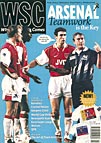 Obsessing over your team will only lead to trouble
Obsessing over your team will only lead to trouble
Nothing gladdens the heart of a news editor more than a series of stories in a short space of time which can be neatly and instantly conflated into a Trend. On the weekend of March 28th-29th, football provided such an opportunity with the death of Fulham fan Matthew Fox outside Gillingham’s Priestfield stadium, the attempted assault on referee Gary Willard at Oakwell and a rather less threatening one-man pitch invasion at Goodison Park. An actual attack on a referee at a rugby league match and the felling of a linesman at Fratton Park earlier in the season were also roped to confirm the alarming new (or rather, old) development.
It was The Ugly Spectre That Still Stalks The World Of Football according to the Daily Express while the News of the World came up with Soccer Dies Of Shame Again, but in fact the various incidents fell into two distinct categories. The tragic event at Gillingham could plausibly be represented as a return to old-style football violence. It occurred as a result of antagonism between two sets of fans, which had little to do with events on the pitch, and it occurred after the game and outside the stadium. No doubt more lessons can be learned about stewarding and policing at Priestfield and elsewhere. But perhaps not too many, except that complacency about the continued existence of hooliganism is the surest way to create conditions for its return.
The incursions on the field at Barnsley and Everton are somewhat different. While their consequences were minimal compared to the devastating impact of Matthew Fox’s death, their implications for football’s future may be more far-reaching. In the past, football fans were rightly condemned whenever their attachment to the game spilled out of control. In the early 1970s there was a spate of pitch invasions in response to events on the pitch – at Leeds v West Brom in 1971, during the Manchester derby at Old Trafford in 1974 and in an FA Cup semi between Newcastle and Forest in the same year – that led eventually to the fences going up. The pitch invasions that happened during the Eighties were much more often targetted at the opposing fans or the police rather than the referee or the players. Now it is the perceived injustice of decisions made by referees (or referees’ assistants) which appears to be the main cause of a renewed willingness among fans to step over the touchline with malicious intent. Those who do so cannot be defended under any circumstances and deserve everything they might get from tangling with an angry Paul Ince.
Such incidents have echoes of the turn of the century when match officials were exposed to the fury of unruly crowds without the protection of organised policing or stewarding or the close attentions of the media. Now they are vulnerable because they are over-exposed above all by television’s ability to dissect their decisions to the nth degree and by television’s willingness to indulge the cult of the obsessive fan. (The trend for presenting football fans as unreasoning obsessives was maintained recently in the BBC’s immensely patronising documentary series about Sunderland, the worst feature of which was the series of interviews with supporters who were filmed at work with scarves draped around their necks as though they couldn’t bear to take them off.)
It was an unhappy coincidence that the incidents at Oakwell and Goodison occurred on the same weekend as the final of the Coca-Cola Cup, whose sponsor has made a virtue of football obsession with its “Eat football, sleep football…” campaign. Until now, companies such as Coca-Cola and, of course, Sky, have seen only an upside in stressing the social acceptability or even desirability of fans who stake everything on the outcome of football matches. The tension-wracked faces of fans involved in championship or relegation dramas have become the staple image of the supporters’ relationship to their team, as seen and, by implication, sanctioned by television and marketing departments.
The scenes at Oakwell should give pause for thought to a few other people in the game too. For example, managers who claim their club is the target of a referees’ conspiracy; players who brandish imaginary red cards at opponents who have fouled them; television commentators who rail at the supposed rising tide of refereeing incompetence; and, above all, a football industry which has come to sanction, if not actually encourage, the idea that what happens to your team is the only thing in life that matters.
From WSC 135 May 1998. What was happening this month